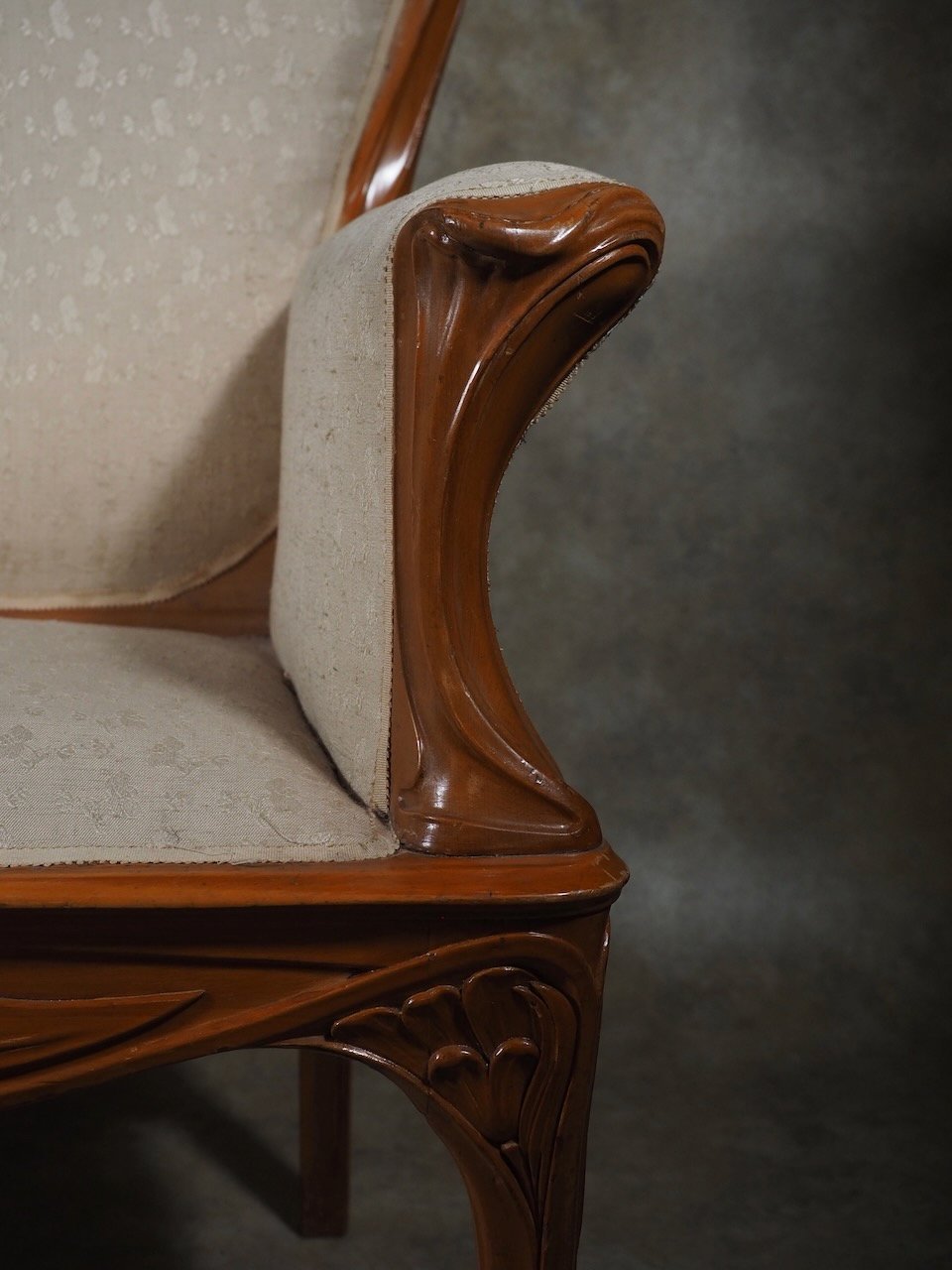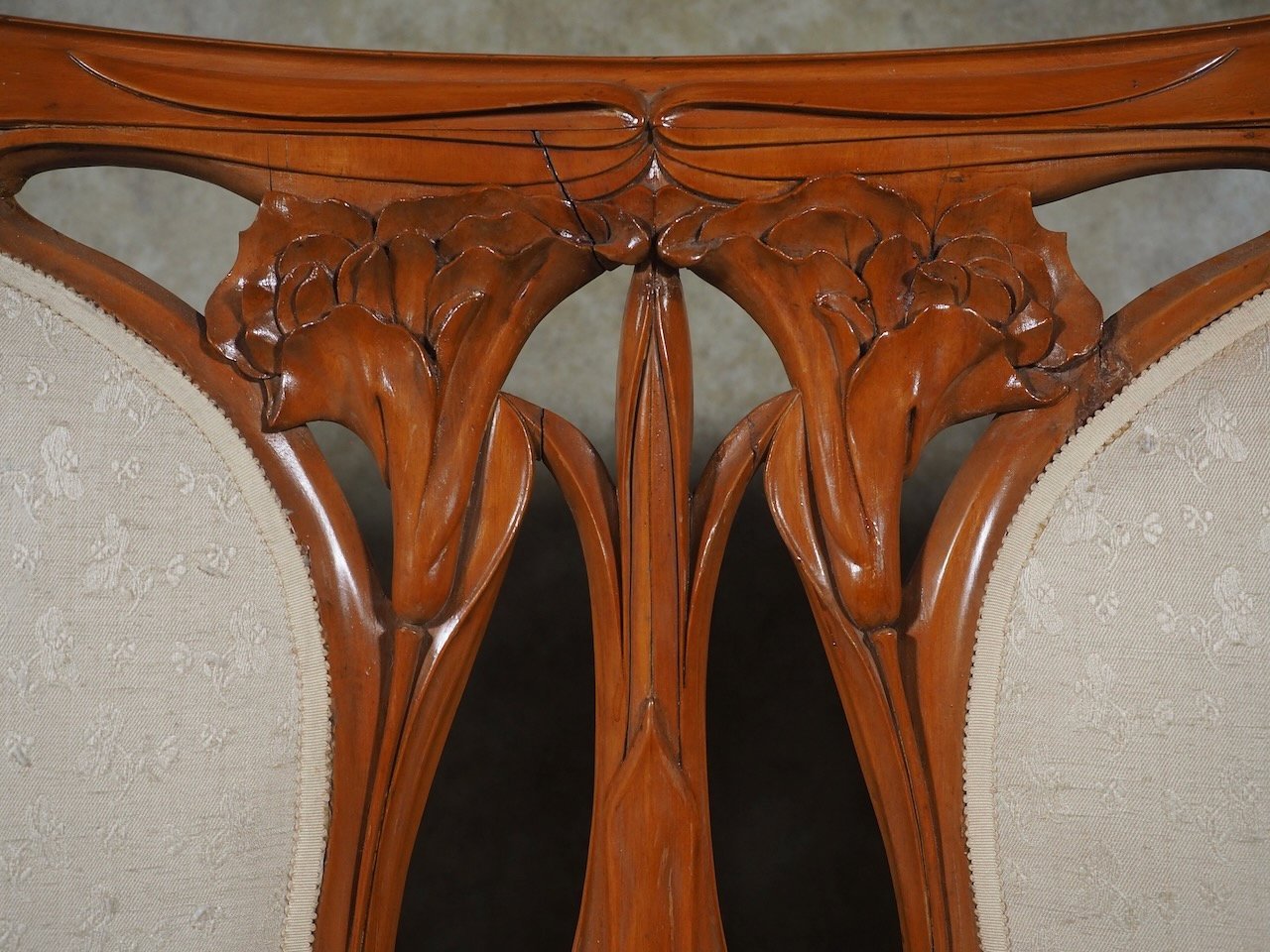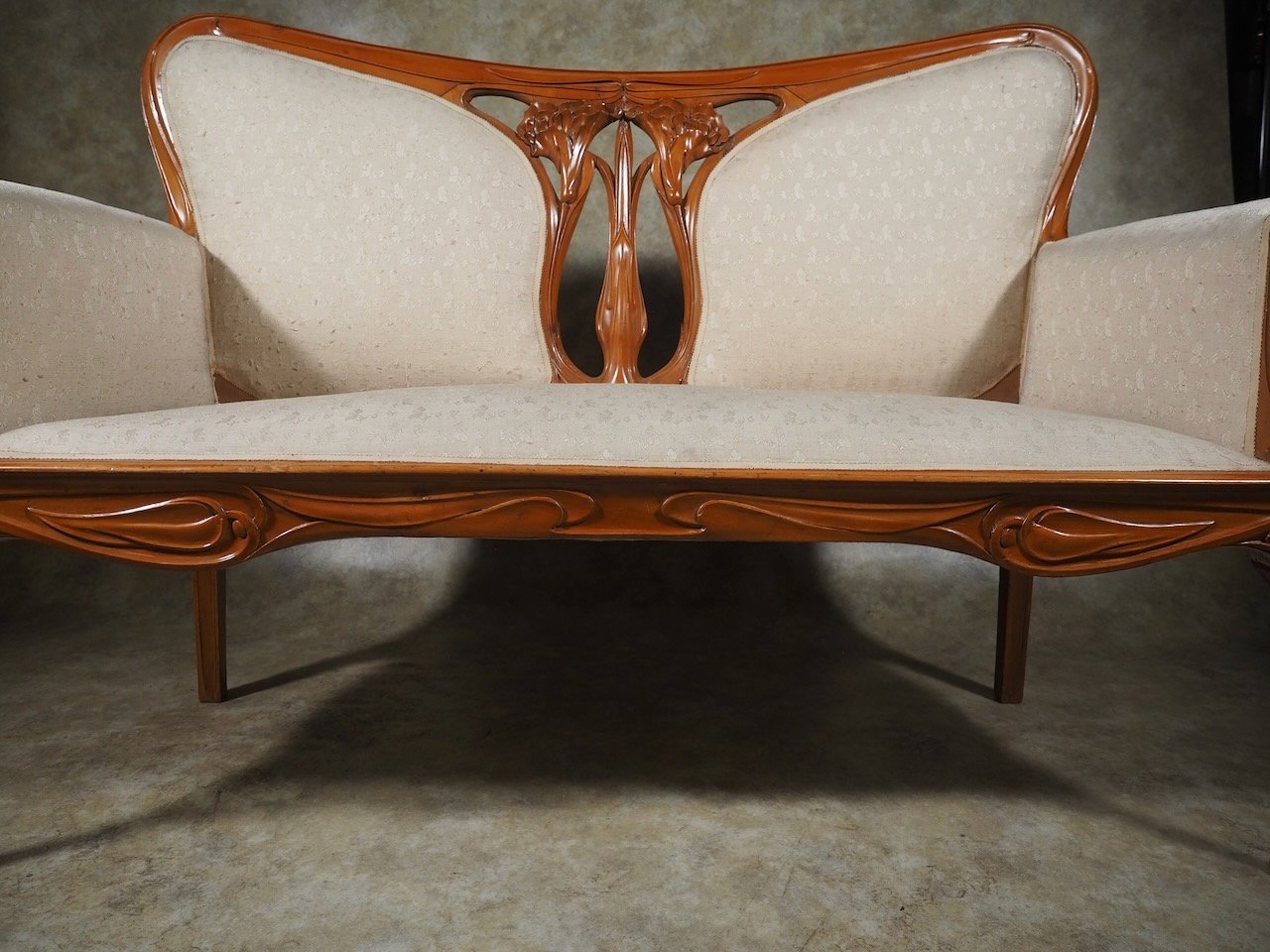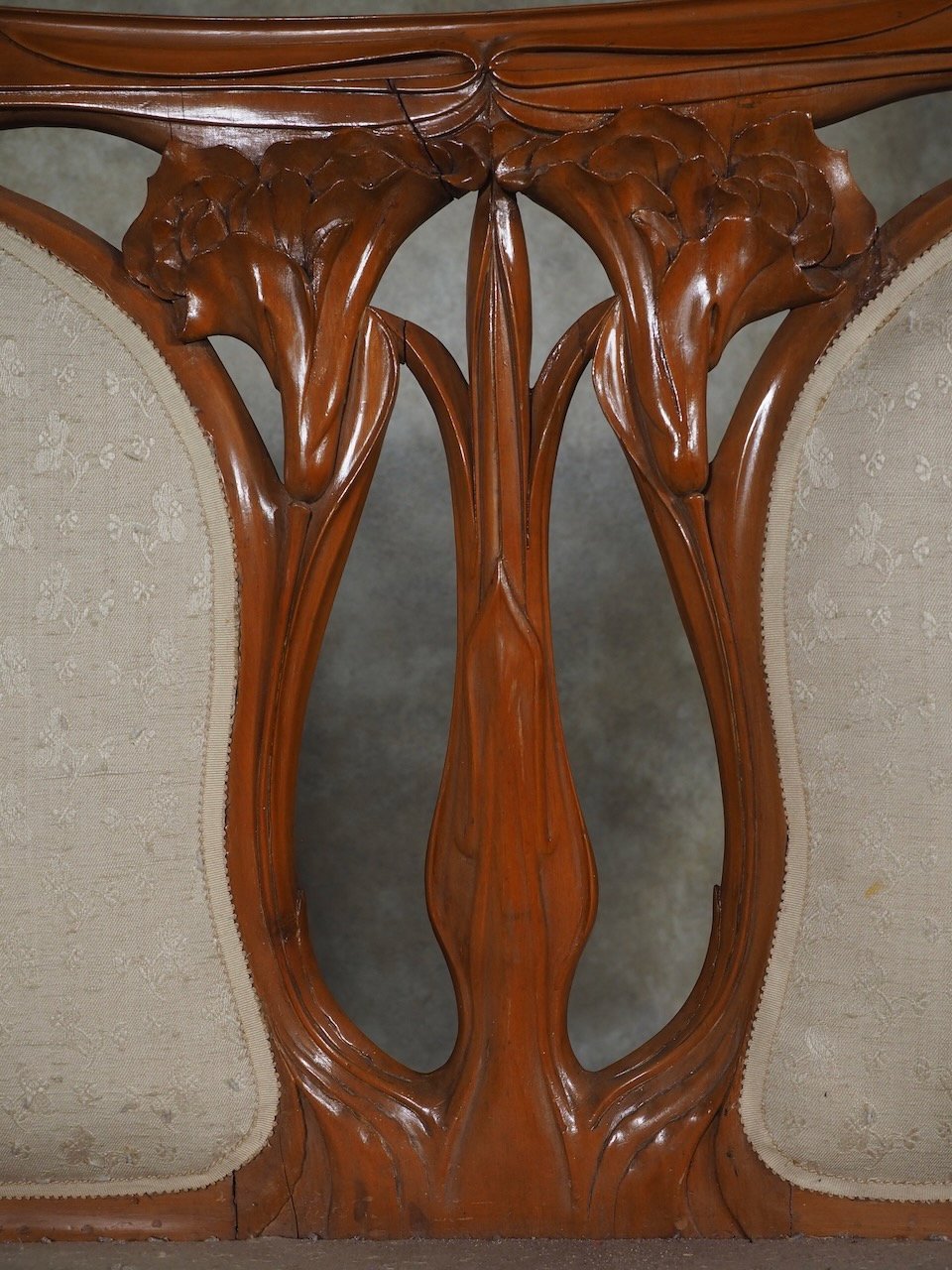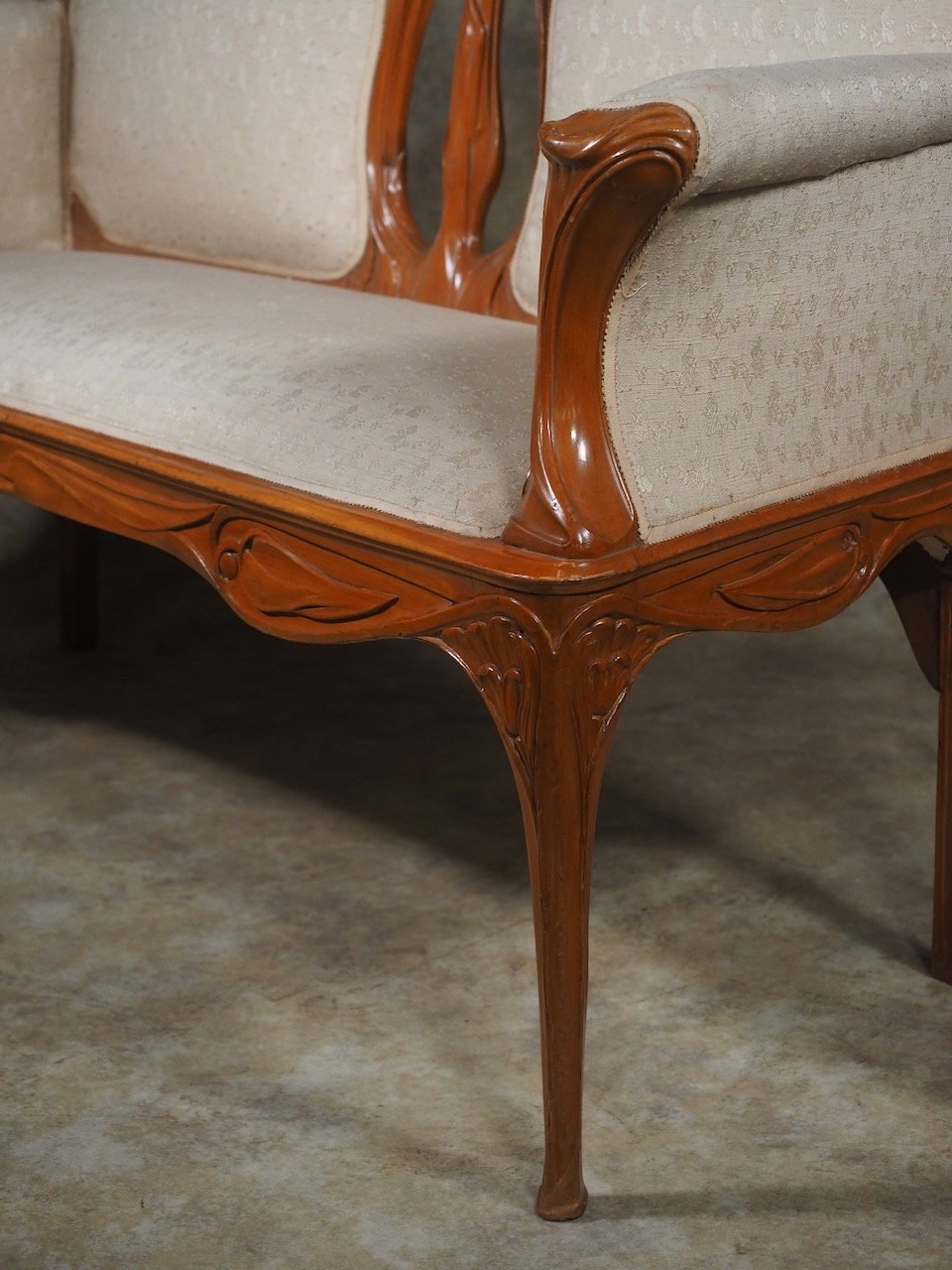Georges de Feure settee, 1900 Expo model (#1715)
French Art Nouveau settee (en suite with #1716 and #1717) by Georges de Feure, model presented in the Bing Pavilion at the Paris Exposition Universelle in 1900. Sculpted pearwood, the suite consists of the settee, pair of armchairs and pair of side chairs. 61” wide x 24” deep x 43” high.
GEORGES DE FEURE (originally Georges Joseph van Sluijters) (1868-1943)
De Feure was born in Paris, the son of a Dutch architect father and a Belgian mother. In 1886 he was one of eleven students admitted to the Rijkscacademie voor Beeldende Kunsten in Amsterdam which he attended for a short while. By 1890 he was in Paris and studied under Jules Cheret and adopted the name ‘de Feure’. His poster designs and illustrations for Parisian periodicals attracted the attention of Siegried Bing, founder of the Paris shop L’Art Nouveau (from which the French design movement gained its name).
During the 1890s, de Feure began designing objects and furniture and his first pieces of decorated furniture and ceramics were shown at the Salon de la Societe Nationale des Beaux Arts in 1894. Along with Eugene Gaillard and Eduoard Colonna he became a principal designer for L’Art Nouveau. And his relationship with Bing resulted in him designing a wide variety of objects and furniture while also maintaining a private clientele.
For the Bing Pavilion at the 1900 Paris Exposition Universelle, de Feure created for the facade the ornate, flowing designs of female figures that embodied the very essence of the high style Bing sought in his atelier.
Art Nouveau Bing epitomized the arts and crafts movement carried to the heights of supreme elegance. No other display at the Exposition received similar intense scrutiny from art journals or had its objects as seriously appreciated and enthusiastically purchased by foreign visitors.
French Art Nouveau settee (en suite with #1716 and #1717) by Georges de Feure, model presented in the Bing Pavilion at the Paris Exposition Universelle in 1900. Sculpted pearwood, the suite consists of the settee, pair of armchairs and pair of side chairs. 61” wide x 24” deep x 43” high.
GEORGES DE FEURE (originally Georges Joseph van Sluijters) (1868-1943)
De Feure was born in Paris, the son of a Dutch architect father and a Belgian mother. In 1886 he was one of eleven students admitted to the Rijkscacademie voor Beeldende Kunsten in Amsterdam which he attended for a short while. By 1890 he was in Paris and studied under Jules Cheret and adopted the name ‘de Feure’. His poster designs and illustrations for Parisian periodicals attracted the attention of Siegried Bing, founder of the Paris shop L’Art Nouveau (from which the French design movement gained its name).
During the 1890s, de Feure began designing objects and furniture and his first pieces of decorated furniture and ceramics were shown at the Salon de la Societe Nationale des Beaux Arts in 1894. Along with Eugene Gaillard and Eduoard Colonna he became a principal designer for L’Art Nouveau. And his relationship with Bing resulted in him designing a wide variety of objects and furniture while also maintaining a private clientele.
For the Bing Pavilion at the 1900 Paris Exposition Universelle, de Feure created for the facade the ornate, flowing designs of female figures that embodied the very essence of the high style Bing sought in his atelier.
Art Nouveau Bing epitomized the arts and crafts movement carried to the heights of supreme elegance. No other display at the Exposition received similar intense scrutiny from art journals or had its objects as seriously appreciated and enthusiastically purchased by foreign visitors.
French Art Nouveau settee (en suite with #1716 and #1717) by Georges de Feure, model presented in the Bing Pavilion at the Paris Exposition Universelle in 1900. Sculpted pearwood, the suite consists of the settee, pair of armchairs and pair of side chairs. 61” wide x 24” deep x 43” high.
GEORGES DE FEURE (originally Georges Joseph van Sluijters) (1868-1943)
De Feure was born in Paris, the son of a Dutch architect father and a Belgian mother. In 1886 he was one of eleven students admitted to the Rijkscacademie voor Beeldende Kunsten in Amsterdam which he attended for a short while. By 1890 he was in Paris and studied under Jules Cheret and adopted the name ‘de Feure’. His poster designs and illustrations for Parisian periodicals attracted the attention of Siegried Bing, founder of the Paris shop L’Art Nouveau (from which the French design movement gained its name).
During the 1890s, de Feure began designing objects and furniture and his first pieces of decorated furniture and ceramics were shown at the Salon de la Societe Nationale des Beaux Arts in 1894. Along with Eugene Gaillard and Eduoard Colonna he became a principal designer for L’Art Nouveau. And his relationship with Bing resulted in him designing a wide variety of objects and furniture while also maintaining a private clientele.
For the Bing Pavilion at the 1900 Paris Exposition Universelle, de Feure created for the facade the ornate, flowing designs of female figures that embodied the very essence of the high style Bing sought in his atelier.
Art Nouveau Bing epitomized the arts and crafts movement carried to the heights of supreme elegance. No other display at the Exposition received similar intense scrutiny from art journals or had its objects as seriously appreciated and enthusiastically purchased by foreign visitors.


